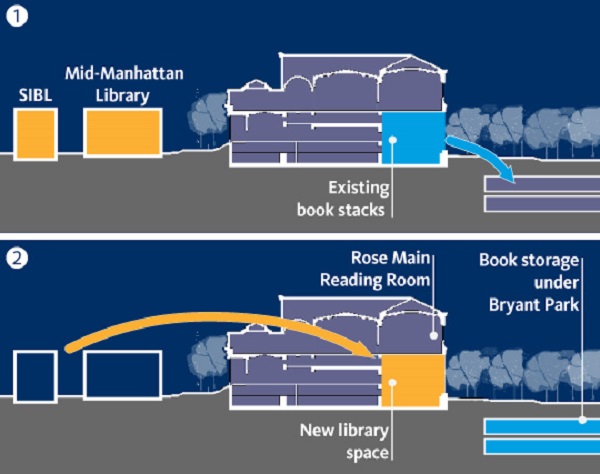2018 School Spending Survey Report
Update: Second Suit Filed to Halt NYPL Central Renovation
Only July 10, the group Citizens Defending Libraries (CDL), together with a coalition of scholars, authors, and preservationists, filed a lawsuit against the trustees of the New York Public Library (NYPL) to stop the demolition and removal of the stacks that support the Rose Reading Room of the Stephen A. Schwarzman Building, as part of a major redesign and renovation of the central library. The move follows a separate suit to halt the plan which was filed by different plaintiffs a week earlier, both with the New York Supreme Court.

This illustration from NYPL shows where the new circulating library would replace existing stacks, whose contents would go into storage under Bryant Park and in New Jersey.
The first suit, filed on July 3rd, seeks the same outcome, but bases its claim on different arguments. Plaintiffs David Levering Lewis, Jacob Morris, Mark Alan Hewitt, Ruth Ann Stewart (a former Assistant Librarian of Congress), and Jack MaCrae claim that the plan will infringe their civil liberties because it will “adversely impact the freedom of speech and information right of all library users and create untenable and unconstitutional barriers to the exercise of the right to receive information.” This claim hinges at least in part on their argument that “it is probable that it will take more than one to two business days for books [removed from the stacks and kept in remote storage in New Jersey] to arrive. It is also probable that some requested books will not be sent at all.” As such, they argue, the library is violating not only the law but also the terms of the trusts which support it financially. (The court filing references a document which supports this claim, but it is not yet available on the New York Supreme Court’s SCROLL system; the plaintiff’s lawyer, nonprofit Advocates for Justice, did not yet respond to LJ’s request for comment.) The first suit also raises a number of procedural objections, claiming the library and the city did not perform the proper economic and environmental impact studies and cost estimate. NYPL President and CEO Anthony Marx recently agreed to commission the cost estimate at a state legislative hearing. But, according to the plaintiffs’ court filings, NYPL considers the recent Branches of Opportunity study by the Center for an Urban Future a sufficient economic study, something the plaintiffs dispute. At the same hearing, Marx said, “we are working with our architects to come up with a design for this new space that will incorporate as much as possible of the historic stacks material.” He also claimed that the material released last December by British architect Norman Foster “was never intended to be a design; it’s not a design.” The first suit also alleges that applications for construction permits claimed the stacks are non-structural when in fact they are structural, and that an application made by one of the plaintiffs for landmark status for the stacks and the Rose Reading Room should be considered before work is allowed to proceed. (In January the Landmarks Preservation Commission voted to allow the plan to proceed, but that vote only addressed the building’s existing landmark status, which is for the exterior.)RELATED
RECOMMENDED
TECHNOLOGY
ALREADY A SUBSCRIBER? LOG IN
We are currently offering this content for free. Sign up now to activate your personal profile, where you can save articles for future viewing









Add Comment :-
Comment Policy:
Comment should not be empty !!!
Michael D. D. White
The NYPL promulgated visual above is startling the way that it deceptively misrepresents what the NYPL is proposing to do in terms of shrinking down library space (which is one of the reasons they are getting rid of books). SIBL the Science Industry and Business Library is diagrammed as if it is the smallest of the spaces they are dealing with. It is actually the largest of the largest of the library spaces at 160,000 sq ft. Mid-Manhattan at about 140,000 sq ft is the second largest although it is made to look about the same size as the representation of the 80,000 sq ft of space where the research stacks are now that would be ripped out. (As recently as 2003 it was proposed that Mid-Manhattan be almost doubled by adding 117,000 additional sq ft to it.) Bottom line, 380,000 square feet of library space is being shrunk down to just that 80,000 sq ft (to be accessed through only one small door way in the back of the building), but the diagram almost makes it look like could all fit without throwing away the books they are throwing out. Also, just looking at the diagram and not reading what it says you might think that Central Reference Library books are NOT being moved off-site to Princeton, New Jersey and/or elsewhere. And you might think that the stack space under Bryant Park is not already being used, did not previously exist, or did not have the intended purpose of also covering future expansion which it will no longer be able to do; all of which would be incorrect.Posted : Jul 12, 2013 02:39